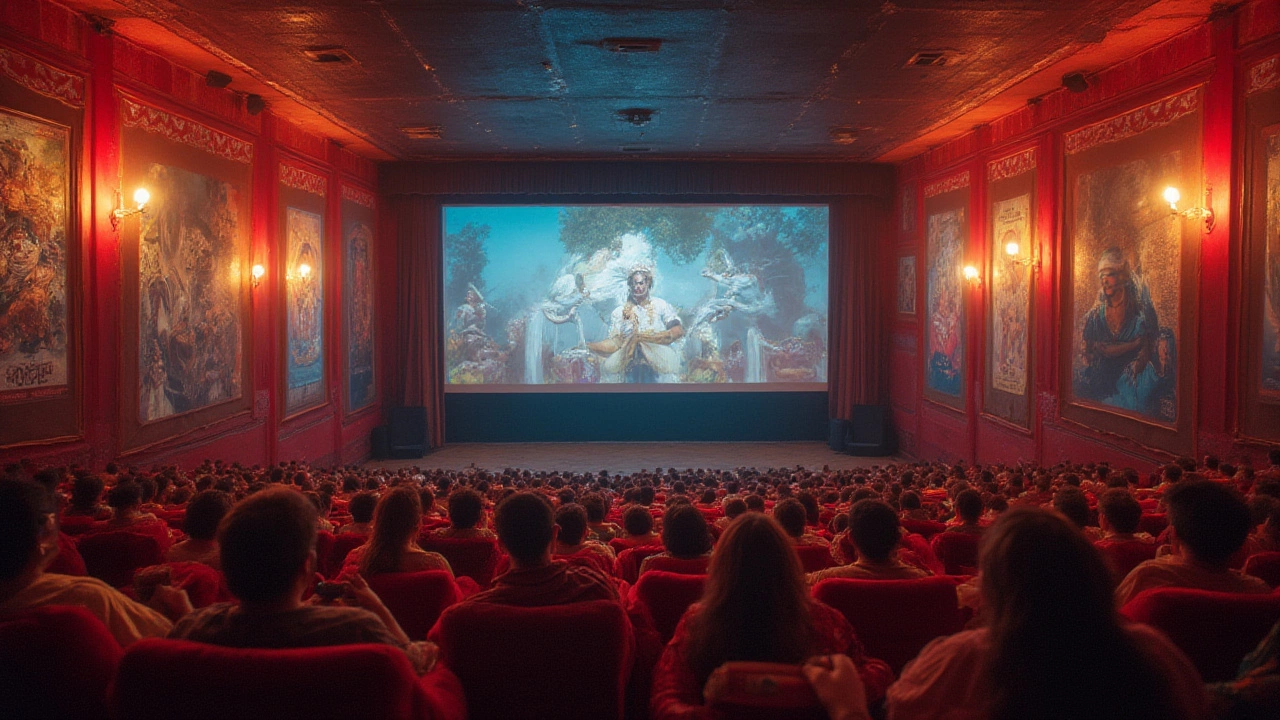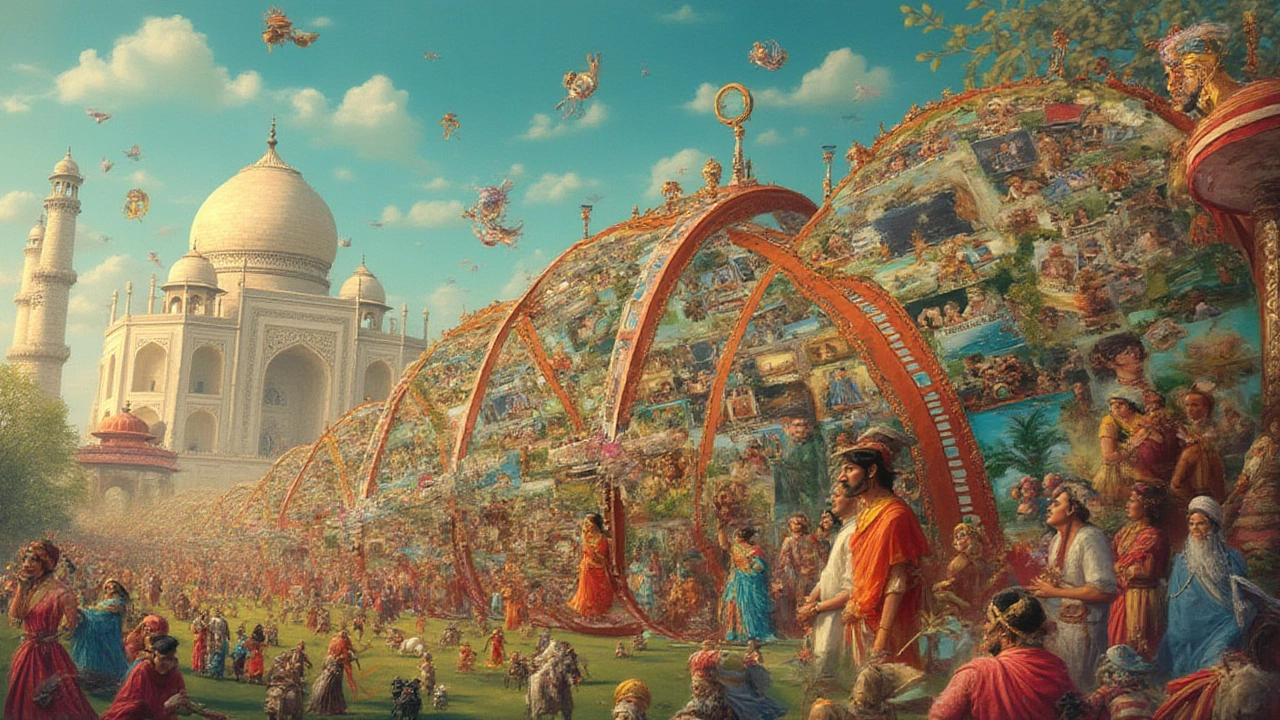Longest Indian Movie Ever Made: Unveiling India's Epic Film Marathon
 Jul, 25 2025
Jul, 25 2025
Picture this: you settle in with popcorn, ready to stream an Indian movie, but by the time you finish, Nimbus—my cat—has napped five times, and you're still only halfway through. Indian movies have a notorious rep for running long, but there's one that beats them all when it comes to sheer run time. Let's jump right into the heavyweights and find out what makes India home to some of the longest cinematic experiences on earth.
The Giant of Indian Cinema: Who Holds the Record?
When you talk about the longest Indian movie, one title sweeps into the spotlight: "Gangs of Wasseypur." Forget your usual three-hour Bollywood epics—"Gangs of Wasseypur" clocks in at a jaw-dropping 319 minutes. That’s five hours and 19 minutes, not counting intermission. Directed by Anurag Kashyap, the film is actually split into two parts for theatrical release, but was originally conceived as a single story, shot back-to-back, and even screened in a marathon format at the 2012 Cannes Directors' Fortnight.
"Gangs of Wasseypur" isn’t just long for the sake of it. It’s a sprawling crime saga set in the coal capital of Dhanbad, loaded with generational feuds, betrayal, dark humor, and a soundtrack that deserves its own playlist. This is not your average masala film—it’s grounded, gritty, and unfurls like a messy family tree, with a cast bigger than some small towns. Anurag Kashyap’s storytelling style doesn’t throw in extra songs or wasted subplots just to pad the runtime; every scene builds either character or atmosphere, creating a gripping narrative that pulls you along, whether you planned to binge or not.
Indian film history is loaded with long movies, but nothing tops this in terms of mainstream, widely seen productions. There are, of course, art films and experimental works (like the documentary "The Clarity of Surrender" at 721 minutes, though that’s a niche title and not a commercial feature). But among feature films, "Gangs of Wasseypur" is the undisputed king. And get this: the cast and crew lived together for months in Varanasi to keep the story’s world authentic. This commitment to realism is a big reason critics celebrate it—The Guardian called it "an extraordinary ride," and Rotten Tomatoes still boasts a score north of 90%. It’s no casual weekend watch, but it's a must-see for film nerds.
People often assume that the usual Bollywood mega-musicals would own the record, but classics like "Mera Naam Joker" (1970, 255 minutes) and "LOC: Kargil" (2003, 255 minutes) still fall way short. Even the ambitious "Sang-e-Meel Se Mulaqat" by Goutam Ghose runs for "just" 414 minutes, but it doesn’t have the mainstream footprint or narrative cohesion of "Gangs of Wasseypur." People love to debate whether splitting the film into two releases disqualifies it as the single longest movie, but Cannes recognized it as one, and that counts for something. Here’s a quick rundown in an easy-to-read table:
| Movie Title | Year | Director | Runtime (minutes) | Mainstream Release |
|---|---|---|---|---|
| Gangs of Wasseypur | 2012 | Anurag Kashyap | 319 | Yes |
| LOC: Kargil | 2003 | J.P. Dutta | 255 | Yes |
| Mera Naam Joker | 1970 | Raj Kapoor | 244 | Yes |
| Sang-e-Meel Se Mulaqat | 2010 | Goutam Ghose | 414 | No (Art/Experimental) |
| The Clarity of Surrender | 2022 | Ananda Dasgupta | 721 | No (Documentary) |
So, if you’re someone who likes to finish a story in one sitting, “Gangs of Wasseypur” is the ultimate Indian film challenge. Just clear your schedule—and maybe keep some snacks handy.
Why Are Indian Movies So Long?
Indian films are famous (or infamous) for having runtimes that put Hollywood blockbusters to shame. But why? A lot of it comes down to cultural habits and audience expectations. Traditionally, movies have been a major outing in India—entire families flock to the theater, plan their day around a single screening, and expect a satisfying, all-encompassing entertainment experience that justifies the ticket price. Short and snappy rarely flies with Indian audiences.
Musicals are baked into the DNA of Indian cinema. Even the darkest dramas and grittiest thrillers often have lavish song and dance sequences. Unlike American movies, where music usually stays in the background unless you’re at a Disney flick, an Indian movie is expected to take center stage with stellar choreographies—some have as many as 10-12 distinct musical numbers. And each song eats up 4-6 minutes of screen time. Multiply that by enough tracks, and it’s easy to see how you breeze past the two-hour mark.
On top of this, Indian storytelling leans on the "masala" format—a little romance, some action, a pinch of comedy, moments that tug your heartstrings, and a climax that demands a standing ovation. A movie shouldn’t leave you feeling hungry for more, so directors tend to go big. Case in point: filmmakers like Sanjay Leela Bhansali or S.S. Rajamouli never shy away from grand narratives. When "Baahubali" dropped, the first part ran for 159 minutes, and part two hit 168 minutes. Now that’s epic.
This concept can baffle folks new to Indian movies. But for longtime fans, the longer, the better. People bring full tiffin (lunch) boxes to cinemas, treat the intermission like halftime at a cricket match, and chat about plot twists during breaks. Fun fact—until the early 2000s, multiplexes weren’t common in India. Single-screen theaters with long movies meant huge, excited crowds and an event-like energy that fed back into filmmakers’ love for grandeur.
Not every movie goes all out, especially with today's streaming services gently nudging run times down. Yet, the tradition lingers. And every now and then, someone knocks out a "Gangs of Wasseypur" to remind everyone what marathon viewing truly means.

Epic Stories, Epic Productions: Behind the Scenes of Lengthy Indian Films
Making a movie that runs longer than some people’s workdays isn’t just about splicing scenes together endlessly. The production of these epics can be a real test of patience, planning, and resourcefulness. Let’s peel back the curtain on how "Gangs of Wasseypur" (and other giants) pulled it off.
First off, there’s the writing. To keep audiences engaged for five hours straight, your script can’t have dead weight. Anurag Kashyap and his team spent months researching Dhanbad’s mafia history, weaving real events with colorful fiction. They poured detail into each generation, each rivalry, with multiple languages and dialects spoken across eras and families. The sheer volume of material to shoot meant this wasn’t your regular, tight–schedule Bollywood film. Actors sometimes had to remember family lines and feuds that spanned decades, making for an intense acting challenge.
The camera work in "Gangs of Wasseypur" is different from flashy Bollywood musicals. Instead of glamour shots and sweeping dance moves, you get gritty, hand-held realism. Dull, beaten landscapes, weathered faces, and cramped living spaces—all done to make viewers feel like they lived in Wasseypur too. The cast grew close during the extended shoot, even forming makeshift football teams between takes, and there are famous stories about shared meals and off-camera pranks that kept morale high during the long slog.
Music can be a double-edged sword in these epics. Instead of just padding time, the soundtrack in “Gangs of Wasseypur” is legendary. Tracks like “Keh Ke Lunga” became cult hits, slyly commenting on the action. Sneha Khanwalkar, the composer, even traveled through North India recording local folk musicians and sounds, trying to get the right vibe.
Editing is where a lot of marathon movies either shine or crash. Editors must shape hundreds of hours of raw footage into a story with flow and urgency. For “Gangs of Wasseypur,” much got left on the blacktop of the editing room. What you see is only the most gripping core—imagine how much more there was. Some say that the uncut footage for Part 1 alone could fill a whole new series. These are movies where even minor characters have biographies longer than some protagonist arcs in shorter films.
It’s not just about duration, though. Long Indian movies need stamina from everyone—not just viewers, but cast, crew, and even distributors. Cinemas needed to plan special schedules to fit in those extra-long showtimes, and staff braced for late nights. Even the promotional tour was an epic saga, with the cast visiting five cities in five days to build hype. To this day, people still swap behind-the-scenes gossip from the sets of “Gangs of Wasseypur,” trading tales about impromptu cricket matches between actors like Nawazuddin Siddiqui and Manoj Bajpai during downtime. That kind of camaraderie is rare on a regular film set, but it holds big ensembles together over months.
Long Movie Survival Guide: Tips for Enjoying the Longest Indian Films
Okay, say you’re ready to take the plunge and watch one of India’s marathon movies. These films can test attention spans and bladder control alike. But trust me, it’s totally doable—and even fun—if you go in prepared. Here’s how I make it to the end, Nimbus snuggled on my lap, and still remember every twist in the plot.
- Block out time, seriously. A movie like "Gangs of Wasseypur" will eat your whole evening (or three). Don’t rush; treat it like running a marathon, not a sprint.
- Break it into chunks if you need to. Even the director envisioned breaks—watching it over two sittings is perfectly OK. Don’t let the purists guilt-trip you.
- Load up on snacks. Trust me, you’ll want both salty and sweet in reach. Bonus survival tip: mix up some classic Indian chai or grab samosas for a true thematic experience.
- Keep friends around. Half the fun is live-commenting the jaw-dropping moments and debating the choices characters make. Make it a group event and the hours pass faster than you think.
- Don’t skip the intermission. It’s there for a reason—give your brain (and bathroom) a break, then dive back in refreshed. Indian filmmakers know you need a breather when you’re slogging through five hours of crime, drama, and revenge.
- If you’re a film geek, keep a notepad handy. With sprawling plots and tons of characters, a few scribbles help you keep track and spot all the clever callbacks.
- Dive into the context. These movies often reference real events, historical settings, and regional customs. Doing a quick wiki-search while you watch can make the experience richer.
- Embrace the music. Don’t hit mute or skip the songs—they’re not just fillers. You’ll miss out on the atmosphere and even surprise plot points. If you’re streaming, turn on subtitles for lyrics, some are genuinely poetic (and savage).
- Take it slow. Not every film has Marvel-style action every ten minutes, but let yourself get swept up in the world. Indian epics are like a slow-cooked meal—you can’t microwave the experience.
Movies are supposed to transport you. The longest Indian films do that by totally immersing you in a world, asking you to care about folks you never thought you’d meet, and keeping you up long past bedtime. Next time you want to try something outside your comfort zone—or prove you’re a film marathoner—queue up longest Indian movie and see if you make it to the end. Just make sure you don’t have early morning plans the next day. Nimbus, for one, recommends multiple catnap breaks. And if you make it? You’ll have a story to tell that’s as epic as the movie you just survived.